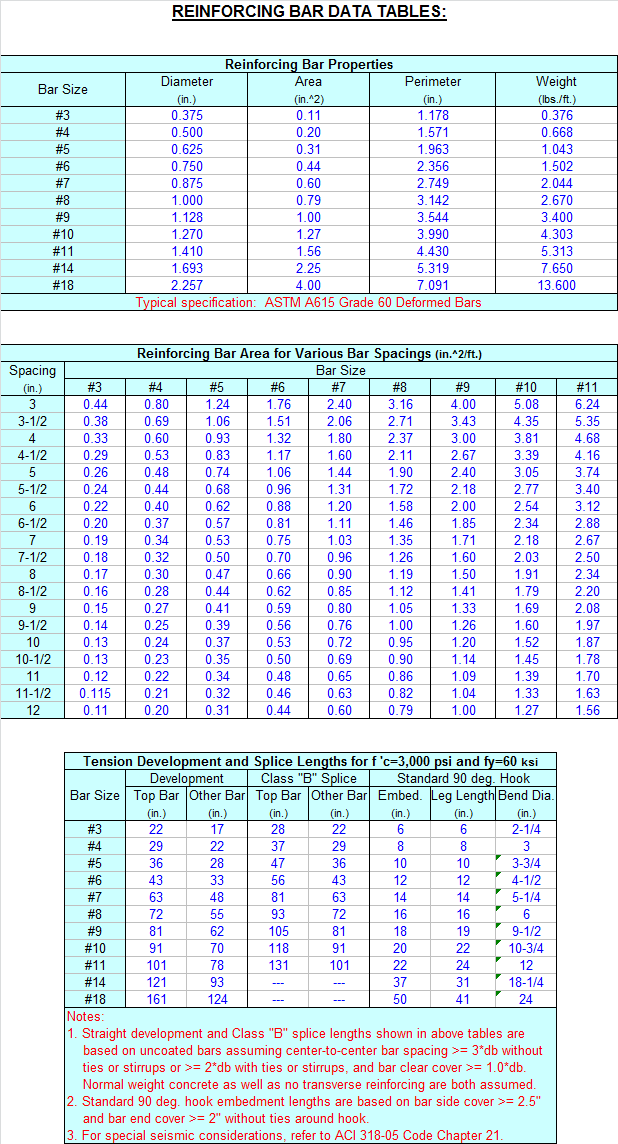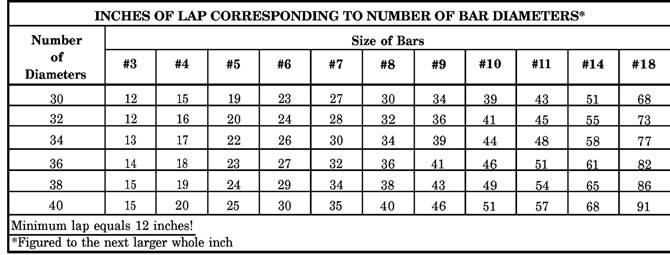

Users should refer to the original published version of the material for the full abstract. 8.32.3.1 The minimum length of lap for tension lap splices shall be as required for Class A, B, or C splice, but not less than 12 inches. No warranty is given about the accuracy of the copy. However, users may print, download, or email articles for individual use. Copyright of ACI Structural Journal is the property of American Concrete Institute and its content may not be copied or emailed to multiple sites or posted to a listserv without the copyright holder's express written permission.The test results were also compared with the predictions by the ACI 408R-03 and Eurocode 2 provisions. For D22 and D32 bars, the use of either transverse reinforcement or thick concrete cover was recommended to develop the specified yield strength of 600 MPa (87 ksi).

The note should simply say: Provide the following lap lengths for reinforcing steel in concrete unless otherwise noted. The results showed that the reinforcing bar splices gave a satisfactory performance for all D13 (diameter = 13 mm ) bar splices. The contents of the schedule of laps is much more important then the note that refers to the schedule. The average bar stresses resulting from this test were compared with the predictions by the ACI 318 provisions. Most of the specimens were designed to satisfy the Class B splice length specified by ACI 318. Concrete strengths ranged from 24.7 to 55.3 MPa (3582 to 8021 psi). Splice types are described in ACI Table 10.7.5.2.2. The test parameters were the reinforcing bar diameter, concrete cover thickness, concrete strength, and stirrup spacing. ACI Table 25.5.2.1 gives the required length of a lap splice as a. Twelve simply supported beams and slabs with reinforcing bar splices were tested under monotonic loading. Abstract: An experimental study was performed to evaluate the applicability of ACI 318 to the Class B splice of 600 MPa (87 ksi) reinforcing bars. Minimum requirements for lap splices in reinforced concrete members, stated in building codes of TS-500 and ACI-318, have a certain factor of safety.
Aci class b lap splice code#
Please!! I need clarifications if this statements of the ACI code must be interpreted literally. Do we really need to interpret this Literally?I mean do we really need to splice it exactly over the support when needed? technically this produces a lot of waste if we should strictly follow this. 2: Lap splices of plain WWR where A s,provided / s,required < 2. The ACI code clearly states that at non-perimeter at least two bars or at least 1/4 of Area of rebars must be continuous or splice(class B tension lap splice) over the support. minimum lap splice length is needed between the outermost crosswires of each reinforcing Fig. I wonder what section of the aci code allows this? Rebar Development Length Calculator is a web application that supports the design of post-installed rebar in concrete applications by calculating the necessary tension and compression development lengths required in accordance with ACI 318-19 / ACI 318-14.


There are two types of splice (A and B) which define the length of the splice as a multiple of the tensile development length (ld. but I do not know in what section of the code allows it. A class A splice is defined in ACI 318 Section 12.15. If I made 2 bottom bars continuous and I had to splice near the column,do I need to stagger the lap splicing? I have seen a link that it is allowed not to stagger it. My question is : if I have 3 top bars and the two top bars ( at the sides ) are made continuous, do we need to stagger the splices? if so, what provision in the ACI code allows this? and do we really need to splice (class B tension lap splice) =it exactly at mid-span? Under gravity loads or in most cases the top bars at mid span and the bottom bars near the supports (in a doubly reinforced beams ) receives compressive stresses. The ACI code gave a provision on structural integrity to perimeter beams is to splice continuous top bars at mid span and splice continuous bottom bars at or near supports. Furthermore, we will (1) treat this as a class B splice (use 1.3 factor) in accordance with section 25.5.2.1 because the bar splices are located along the same edge of the footing and (2) add 3 to account for the concrete cover leading up to the existing reinforcing bars.


 0 kommentar(er)
0 kommentar(er)
